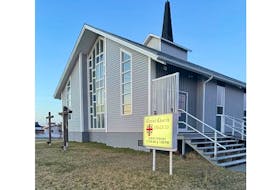CENTRAL, N.L. – As it stands, Nolan Newbury won’t be salmon fishing this year.
The Springdale angler’s comments followed the Department of Fisheries and Oceans Canada (DFO) announcement, May 7, that retention angling would be limited to one salmon, with a possibility for extension following a mid-season review.
Last year, there were six salmon tags issued per angler.
Furthermore, catch and release limits were reduced to three fish per day for all rivers in Newfoundland and Labrador. Previously it was four per day.
Related: Salmon conservation groups applaud reduced retention
“It breaks my heart, but I cannot support what they have in place,” Newbury said. “I’ve got a $1,000 worth of salmon gear in my shed, but I’m done with it until someone develops a bit of common sense.”
He called the issuing of one tag a money grab, offering just enough to draw retention anglers into buying a licence.
“It’s a bunch of skullduggery,” he said. “Anglers have to pay $30 for a license to catch one fish, and then they’ll debate whether or not we’re able to keep another one, it’s an insult.”
“As far as I’m concerned it’s set up to be a catch and release only fishery.”
Newbury feels he should be able to retain four fish, as per previous licensing arrangements. He doesn’t participate in the fall fishery that allows for an additional two salmon to be tagged.
He has been fishing West Brook, between Springdale and South Brook, for more than 40 years.
Last year, the season was closed because weather and water conditions were poor. It remained closed to retention angling after provincial salmon returns were low.
Even though there’s no fishway counter on the brook, Newbury said there were plenty of salmon in his fishing area, and, this year, salmon are already entering the waterways.
“I know it’s hard to believe, but I’ve had them in my hands, catch and release,” he said. “They are in the lake taking the raw lure.
“And that’s the thing that kills me about this. (DFO) don’t want to hear what we’ve got to say, even though we’re the ones who spent a lifetime on the rivers.”
Calvin Francis, chief of the Gander Bay Indian Band council, doesn’t feel his people were listened to either.
The council had recommended the retention of two, up to four, salmon.
“For those who angle to retain salmon, if the salmon are plentiful, they could finish up their angling season in five minutes,” he said. “It results in less angler presence, which poses a problem, as less anglers can bring about increased poaching.”
There was no way the council would have endorsed a catch and release only format.
And he’s weary the catch and release reduction will even make a difference.
“It’s an imaginary number that is difficult to police. It can and has been outrightly abused,” he said.
But overall, Francis called it better than nothing.
“It allows people to fish, the industry to continue, and it won’t result in the loss of jobs or the closure of the lodges,” he said.
If anglers are to have a chance at retaining additional salmon this summer, he said, the proof needs to be at the counters.
If the numbers are strong, it should entice DFO to provide additional salmon tags.
Serving as the Salmon Brook fishway coordinator, near Glenwood, Francis said his group will be opening the counting facility on May 14, earlier than usual, in case salmon are on the move early.
“With the right conditions, it’s possible,” he said about this year’s numbers being up. “But we need to make sure we have everything in place to get the best possible count we can get.”
In response
An interview with a DFO representative could not be arranged before deadline.
However, a department statement read, “This decision reflects the need for conservation and sustainability while recognizing the socioeconomic impact and tradition of angling in our province.
“It’s important to note the recent stock assessment for salmon found, that in 2017, 75 per cent of assessed rivers in Labrador, and 60 per cent of accessed rivers on the island portion of the province, were in the critical zone. Eighty per cent of assessed rivers (12 out of 15) showed declines of more than 30 per cent in total returns compared to the previous 5-6 years, which was a similar trend to 2016.”
The Department indicated input from stakeholders around the province was considered in making the reduction decision.
The 2018 Atlantic salmon recreational fishery for insular Newfoundland runs from June 1 to Sept. 7, in Labrador, from June 15 to Sept. 15.
Details on the regulations pertaining to bag limits, river classification, closed areas and special management areas are contained in the 2018 - 2019 Angler's Guide which will be available soon in booklet form or on-line at www.nfl.dfo-mpo.gc.ca/NL/AG/anglersguide








